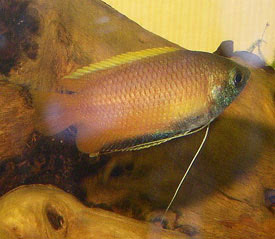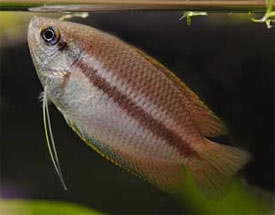
 Magyarul / Hungarian
Magyarul / Hungarian


- Scientific name: Trichogaster chuna
- Synonyms: Colisa chuna, Colisa sota, Polyacanthus sota, Trichopodus chuna, Trichopodus sota
- Common name: Honey gourami
- Group: Labyrinth fishes
- Habitat: Asia; Northeast India, Banglades
- Size: 4 cm
- Biotope: Slow-moving rivers
- Social behavior: A peaceful and timid species that can be combined with other peaceful species. Males become aggressive when defending their brood at spawning times.
- Diet: Live, insect larvae, Tubifex, insects, crustaceans, flakes, occasionally algae, pellets, tablets
- Breeding: Breeding is moderately difficult.
- Tank: Minimum 50 litres
- Population: 1 couple for 50 litres
- Decoration: Thick vegetation
- Temperature: 24-26 °C
- pH: 6,5-7,2.
- Hardness: 5.6-8,4NK°
- Lifespan: 4 years
Description: Base color is pale Ocher, with a faint silvery sheen which becomes more pronounced towards the belly. A dark Brown band runs from the eye to the beginning of the Cauda fin. During courting males attain a very brilliant coloration; the sides of the body including the back part of the Dorsal, Anal and Caudal fins become bright Honey-Yellow to flame Red-Orange. The spiny rays of the Ventral fin are orange and the Anal fin has reddish tips. Note: this fish usually appears almost colorless in dealers tanks.
A peaceful species that benefits from a fairly large aquaria. The tank should be densely planted and also contain some floating plants if possible Its tank-mates should be small peaceful lower tank dwelling species. Feeding is not a problem as they take prepared staple food along with supplements of live and frozen food.
Their pH should be slightly acidic {6.5} to neutral {7.0}, GH is acceptable in almost all ranges. Temperature range of mid seventies to low eighties. They dwell in the middle to upper areas of the tank.
The gouramies are bubble-nest egg layers. The nest are always built by the male and its shape and size depends on the species. The nest is made at the surface among the floating plants. The male courts the female under the nest, where he curls around her and turns her belly-up. The eggs are laid and fertilized in this position. The eggs float up to the nest where the male will keep a constant watch. He will chase away all intruders including the female, as well as keeping the nest in constant repair. Any eggs or fry that fall from the nest will be quickly scooped up and gently spat back into the nest. The eggs hatch in about twenty-five to thirty hours and the fry become free swimming in four to five days. They are very small and must be fed fine flake or live food. They grow very quickly. Mating can usually be triggered by lowering the water level and raising the water temperature. The higher water temperature should be maintained for several weeks after hatching.









